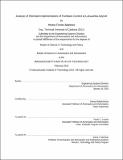| dc.contributor.advisor | Hamsa Balakrishnan. | en_US |
| dc.contributor.author | Fornés Martinez, Hèctor | en_US |
| dc.contributor.other | Massachusetts Institute of Technology. Department of Aeronautics and Astronautics. | en_US |
| dc.coverage.spatial | n-us-ny | en_US |
| dc.date.accessioned | 2015-07-31T18:18:31Z | |
| dc.date.available | 2015-07-31T18:18:31Z | |
| dc.date.copyright | 2015 | en_US |
| dc.date.issued | 2015 | en_US |
| dc.identifier.uri | http://hdl.handle.net/1721.1/97944 | |
| dc.description | Thesis: S.M. in Technology and Policy, Massachusetts Institute of Technology, Engineering Systems Division, 2015. | en_US |
| dc.description | Thesis: S.M., Massachusetts Institute of Technology, Department of Aeronautics and Astronautics, 2015. | en_US |
| dc.description | This electronic version was submitted by the student author. The certified thesis is available in the Institute Archives and Special Collections. | en_US |
| dc.description | Cataloged from student-submitted PDF version of thesis. | en_US |
| dc.description | Includes bibliographical references (pages 138-141). | en_US |
| dc.description.abstract | Implementations of surface traffic management strategies at congested airports have the potential to yield significant benefits, but must account for the constraints and objectives of multiple stakeholders. This thesis considers the implementation of pushback control policies at LaGuardia Airport in New York. This class of control policies regulate departure pushback rates by holding aircraft at their gates during congested periods, in a manner that maintains the departure throughput of the airport while reducing the taxi-out time. Such a time reduction leads to reductions in fuel burn and emissions. The main contribution of this thesis is the consideration of gate-holding limits at the gate which aim at including operational benefit-cost analysis in addition to the pushback control. The main consequence of those gate holds are gate conflicts and take-off order swaps, which are analyzed in detail throughout this thesis. The results show that taxi-out savings are a nonlinear and increasing function of gate-holding limit, and thus, more benefits are expected from longer gate conflict limits. However, the non-linear component creates opportunities for additional benefits with marginal cost increases. On the cost side, gate-holding times are the biggest component, but are commensurate with the benefits. One held minute translates to one saved minute in taxi-out; this finding holds true regardless of the gate-holding limit. Departure order swaps and gate conflicts increase as stricter limits are imposed on the gate-holding times, but not significantly. The benefits and costs are shown to be approximately equivalent to the share of the airlines departures at LaGuardia, demonstrating a fair allocation strategy. | en_US |
| dc.description.statementofresponsibility | by Hector Fornes Martinez. | en_US |
| dc.format.extent | 141 pages | en_US |
| dc.language.iso | eng | en_US |
| dc.publisher | Massachusetts Institute of Technology | en_US |
| dc.rights | M.I.T. theses are protected by copyright. They may be viewed from this source for any purpose, but reproduction or distribution in any format is prohibited without written permission. See provided URL for inquiries about permission. | en_US |
| dc.rights.uri | http://dspace.mit.edu/handle/1721.1/7582 | en_US |
| dc.subject | Engineering Systems Division. | en_US |
| dc.subject | Technology and Policy Program. | en_US |
| dc.subject | Aeronautics and Astronautics. | en_US |
| dc.title | Analysis of potential implementations of pushback control at LaGuardia Airport | en_US |
| dc.type | Thesis | en_US |
| dc.description.degree | S.M. in Technology and Policy | en_US |
| dc.description.degree | S.M. | en_US |
| dc.contributor.department | Massachusetts Institute of Technology. Department of Aeronautics and Astronautics | |
| dc.contributor.department | Massachusetts Institute of Technology. Engineering Systems Division | |
| dc.identifier.oclc | 914803803 | en_US |
